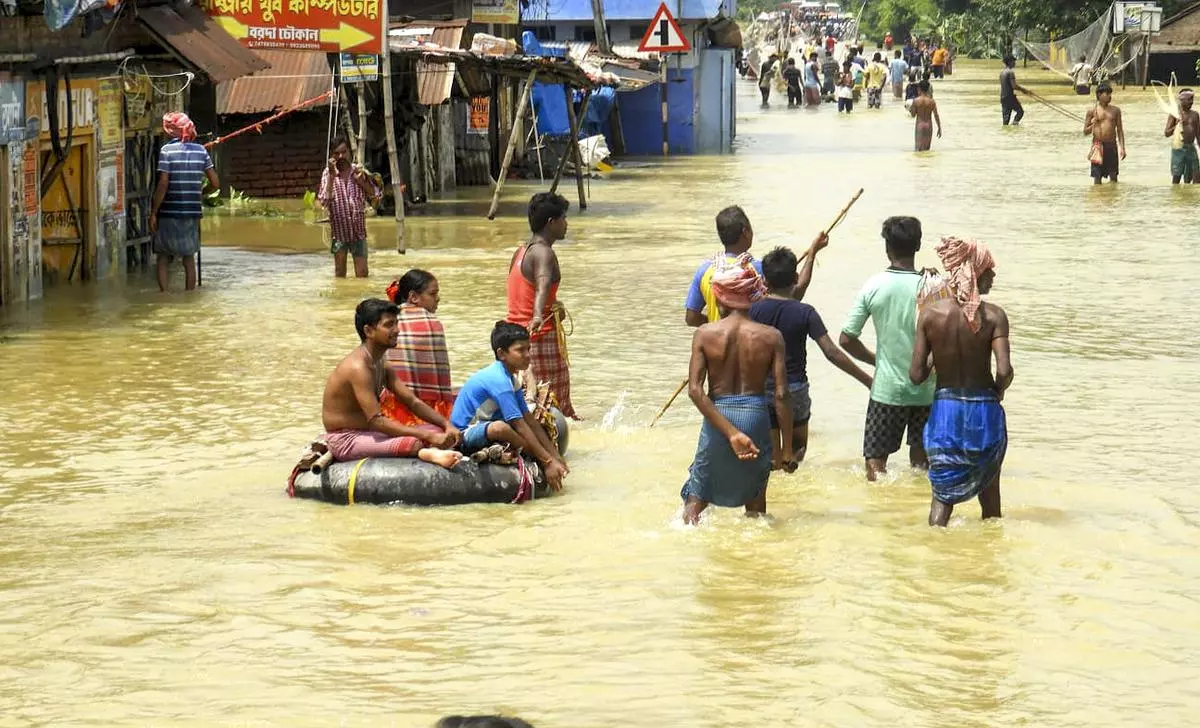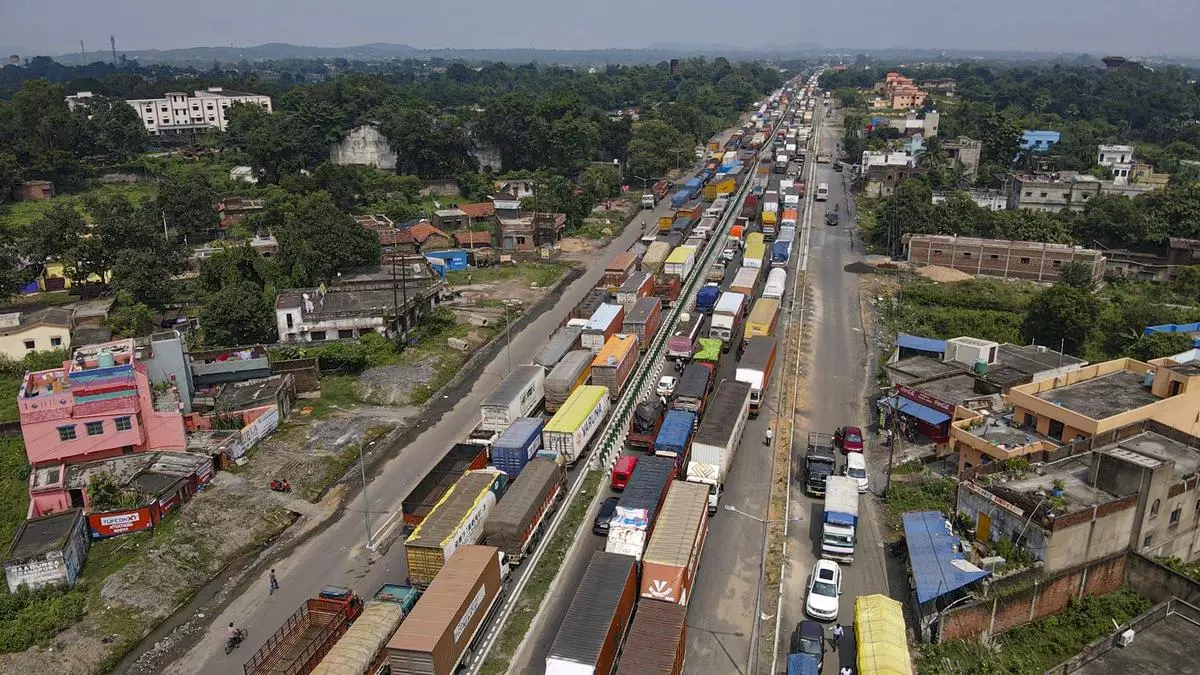
The annual bickering between the Government of West Bengal and the Centre over the Damodar Valley Corporation (DVC) releasing water and causing floods in south Bengal has become a political tradition of sorts in the State, dating back to the Left Front regime that was in power until 2011. However, this year’s clash marked a new low, with Chief Minister Mamata Banerjee accusing the DVC of deliberately flooding Bengal to protect neighbouring Jharkhand, and even threatening to “sever ties” with the Corporation, which is based in Kolkata.
According to the State government, this year’s flooding was the worst caused by the DVC’s release of water since 2009, affecting around five million people (with 28 fatalities) in an area stretching over 1,000 square kilometre. The affected districts are Purba Bardhaman, Paschim Bardhaman, Birbhum, Bankura, Howrah, Hooghly, Purba Medinipur, and Paschim Medinipur. The State government came down heavily on the Centre for the flooding just ahead of the Durga Puja, the biggest festival in the State.
Mamata Banerjee, who said the flood was “man-made”, wrote to Prime Minister Narendra Modi saying that it was caused by an “unprecedented, unplanned and unilateral release of an enormously huge volume of water, at nearly five lakh cusec from the combined system of Maithon and Panchet dams owned and maintained by the DVC”.
Bengal was lashed by heavy rains between September 13 and 16, and the DVC’s discharge of water exacerbated an already flood-like situation.
Also Read | A life eroded in Samserganj
Mamata Banerjee claimed that on September 16, her government requested the DVC to defer the release of water and that she herself spoke to DVC chairman Suresh Kumar on that night. “In spite of all these, combined dam release was increased in quick successions in the early hours of September 17, 2024, from 90,000 cusec (at 11:20 pm on September 16) to 2,50,000 cusec within just nine hours (till 8:10 am on September 17)… The total discharge during the short period of three days is equivalent to 8.31 lakh acre-feet up to the last available report,” she wrote in her letter to Modi on September 20. She also warned that if the DVC persisted in its “unilateral approach” of discharging water, the State “will be left with no option but to disengage entirely from DVC”. “We cannot allow this ongoing injustice to affect our people year after year,” she wrote.
Flooding of Bengal was a ‘premeditated move’
Putting a political twist to the conflict, Mamata has alleged that the flooding of Bengal was a “premeditated move by the Centre just to save Jharkhand from flooding”. After touring some of the affected places, she said: “The Centre does not dredge the DVC dams; and I am tired of telling them time and again… However, actions from the Government of India and the DVC have so far been limited to studies, investigations, and half-hearted attempts to formulate projects… it released water with a design to flood Bengal… Several thousand villages in Bengal have lost everything because of this strategy of DVC.”
Highlights
- Floods in south Bengal have affected about five million people (with 28 fatalities) in an area stretching over 1,000 square kilometre.
- Release of water by the DVC from the Maithon and Panchet dams exacerbated an already flood-like situation., drawing an angry torrent from Mamata.
- DVC releases in the late monsoon months have been causing this kind of disaster for many years now, causing friction between the Centre and State.
Mamata’s allegations led to a bitter exchange between the Centre and the State. Reacting to her September 20 letter to Modi, Minister of Jal Shakti C.R. Paatil wrote back to her on the same day claiming that West Bengal officials were “consulted and kept informed at each and every stage”. “I am further informed that on account of heavy rainfall in south Bengal and on request from West Bengal officials, release from the two reservoirs was initially curtailed to almost 50 per cent during 14th to 17th September, 2024. However, due to very heavy rainfall on 16th and 17th September, 2024, by early morning of 17th September 2024, it became imperative for the [Damodar Valley Reservoir Regulation] Committee to substantially enhance the releases in order to avoid any catastrophic impact in south Bengal due to possible dam failures.” Paatil maintained that the Damodar Valley Reservoir Regulation Committee (DVRRC) had made “all efforts” to minimise releases to avoid flooding south Bengal, and that the releases that were finally made “were essential and any reduction in the same may have led to a much larger catastrophe in the State”.
An aerial view of the flood-affected areas in Howrah district on September 21.
| Photo Credit:
SHYAMAL MAITRA/ANI
The Chief Minister countered Paatil’s letter with another letter to Modi on September 21 with a list of refutations. She claimed that Paatil’s statement that all efforts were made to minimise flooding was “not entirely accurate” and alleged that all “critical decisions” are made unilaterally by representatives of the Central Water Commission [falling under the Ministry of Jal Shakti]. Sometimes, water releases take place even without any notice to the State government and the requests and views of the Government of West Bengal are not honoured, she alleged.
She reiterated that the peak discharge of 2.5 lakh cusec could have been avoided as the Maithon and Panchet reservoirs had not reached their Maximum Flood Management Levels of 495 feet and 425 feet, respectively. She drew the Centre’s attention to the two major schemes that are still pending inclusion under the Flood Management and Border Areas Programme (FMBAP)─the Rs.1,238.95 crore Ghatal Master Plan, and the Rs.496.7 crore Flood Management Scheme for Uttar Dinajpur, Dakshin Dinajpur and Malda.

People wading to safety In Paschim Medinipur district on September 20.
| Photo Credit:
PTI
The same day, the West Bengal government’s representatives in the DVRRC, the State Power Secretary and the Chief Engineer, Irrigation & Waterways, resigned from the DVC board. Power Secretary Santanu Basu said in his resignation letter to DVC chairman S. Suresh Kumar: “In view of the unprecedented and uncontrolled release of water by the DVC from its dam systems, leading to widespread inundation causing immense sufferings to the people in vast areas of the state, I do hereby tender my resignation as the member of State from the board of DVC.”
What provokes the angry torrent?
The flood situation, undoubtedly, has been serious, but it has been an annual phenomenon for many years now. Hence some observers see a political motive behind Mamata’s ultra-aggressive stance this year. The veteran political analyst Biswajit Bhattacharya said: “Never have we seen Mamata so cornered as she is now with the R.G. Kar case, and the continuous protests over it. This is a difficult situation to be in for an aggressive leader like Mamata Banerjee, whose forte lies in reactive politics. The flood situation has given her an opportunity to finally lash out against the BJP and the Centre. Just as the R.G. Kar rape and murder has created a social upheaval, the floods, too, have affected society in a big way, which serves the purpose of diverting public attention from the R.G. Kar tragedy.” Bhattacharya also pointed out that for a cash-starved State like Bengal, this was an opportunity to “create pressure for funds for relief”.

Trucks stranded on National Highway 19 on September 20 after West Bengal sealed its border with Jharkhand.
| Photo Credit:
PTI
The floods also provoked a brief but unseemly spat between the governments of Bengal and Jharkhand, the other State that has representatives in the DVRRC. On September 19, Mamata Banerjee announced the sealing of the Bengal-Jharkhand borders for three days, apparently because of water levels rising in National Highway 16. This drew an angry reaction from Jharkhand’s ruling Jharkhand Mukti Morcha (JMM), which in turn threatened to seal the border and not allow trucks into Bengal. “Mamata will have to pay a heavy cost if she seals the borders. If Jharkhand also seals its borders, West Bengal will be cut off from the west, north and southern India… We will block all goods trucks carrying foodgrains and other commodities into West Bengal if it seals borders,” said JMM general secretary Supriyo Bhattacharya.
Also Read | India’s climate strategy: Balancing growth with green commitments
The face-off lasted nearly 12 hours, with goods trucks piling up on both sides, before Bengal reopened the borders. The border-sealing drew flak from multiple sections. The psephologist and academic Biswanath Chakraborty told Frontline: “This was not properly thought out by Mamata. It went against the constitutional rights of the people; against the spirit of the Constitution and federal principles; and it was against the spirit of the Indian National Developmental Inclusive Alliance of which both the Trinamool and the JMM are partners.”
The political bickering over the floods did not end with the DVC’s discharge of water. When heavy rain caused floods in north Bengal and the release of water from Nepal produced inundation in Malda and Murshidabad, Mamata once again joined issue with the Centre, saying the Union government did nothing to alleviate the situation. She accused the Centre of not undertaking any maintenance work on the Farakka barrage in Murshidabad “despite repeated reminders” and that this had reduced its water-bearing capacity.
The fact that a State and the Union Government are repeatedly engaged in a slugfest over something as serious as flooding that affects lakhs of people every year points to a lack of systems and processes that should have been in place to ensure transparency and accountability.





